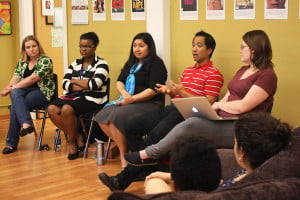Four percent of Stanford students reported having been raped, while seven percent reported having been sexually penetrated against their will and 15 percent reported engaging in intercourse under pressure, according to preliminary data from a survey of roughly 4,000 students conducted by Health Promotion and Services (HPS). Donnovan Yisrael ‘88, M.A. ‘89, HPS manager of relationship and sexual health programs, and Byrd Bannick ‘13 presented the results of the data to students at the Women’s Community Center Thursday evening.
HPS introduced the data as part of Thursday’s “Symposium on Sexual Assault” hosted by Stanford V-Week and the Stanford Survivor’s Group. Students and administrators discussed University response to sexual assault and rape and addressed the incidence rate of sexual crimes on Stanford’s campus. They also identified a student culture that does not consistently recognize penetration against one’s will–or penetration under pressure–as rape.
HPS will formally release the data in the coming weeks.

The symposium consisted of a dozen students and five panelists from the Office of Judicial Affairs, the newly formed Office of Sexual Assault and Relationship Abuse (SARA), the Women’s Community Center and the iThrive program.
Bannick and Yisrael noted that nine percent of students, 13 percent of straight women, 28 percent of students who identified as bisexual, gay or lesbian, 11 percent of gay men, and 15 percent of people who refrained from marking gender reported that they experienced attempted unwanted penetration.
Over 50 percent of those surveyed reported forcible fondling or unwanted touching or kissing.
The survey also explored to whom victims turn to for support: 66 percent went first to a female friend, 29 percent turned to a male friend, 28 percent talked to no one, 19 percent called a parent and 12 percent reported the incident to a resident assistant (RA).
The panel also spoke about the “alternative review process” introduced two years ago. Jamie Hogan, a student affairs officer in the Office of Judicial Affairs, discussed the change in policy and noted a positive effect on the number of completed cases.
“The number of cases that have gone through a hearing has increased dramatically,” Hogan said.
The biggest change from the previous process, which included simultaneous cross-examination of the victim and the perpetrator before a six-person panel, was a change to the standard of proof, Hogan said. Now, the panel is asked to act on probable proof rather than proof beyond a reasonable doubt.
Under the new process, Hogan discusses the judicial process with the victim and hears the victim’s report. She then sends the victim her notes to fact check and confirm the victim wants to move forward, she said.
Next, a panel of three students and a faculty member review information collected from other involved parties–witnesses and the alleged perpetrator–before optional individual meetings are held with the victim and the alleged perpetrator.
Finally, a verdict is made as to whether or not a University policy has been violated and the victim is consulted before any disciplinary action is taken. According to Hogan, a standard punishment is loss of housing and being asked to leave the University for as long as the impacted student is enrolled.
“The Sexual Violence Advisory Board advised consideration of expulsion, but the reviewers have not done that,” Hogan said. “They have instead moved toward suspension while the victim is enrolled.”
Angela Exson, assistant dean of SARA, noted that “statistics tell us that [it is] a very small group of men committing [sexual] crimes many times.”
“The average offender will commit [sexual] crimes seven times before any action is taken against them,” she said.
An audience member then brought up her experience with a friend who “didn’t want the social repercussions of getting [the aggressor] kicked out.” The student asked how best to respond to friends looking for help.
“The operative word is options, not advice,” responded Exson. “The most important thing is being armed with the resources.”
Several administrators acknowledged that it can be confusing for students to navigate all the resources that are available for victims of sexual assault and relationship abuse in the immediacy of responding to abuse or assault. They cited the SARA office (650-725-9129), the 24-hour Stanford dedicated hotline (650-725-9955), Vaden Health Center and free and confidential sexual assault exams at the Santa Clara Valley Medical Center in San Jose.
Victims can choose to pursue legal processes through Stanford’s Office of Judicial Affairs, through University police, or both. Counseling and Psychological Services (CAPS), the WCC, the Bridge and the LGBT-Community Resources Center also provide services to students working through psychological and emotional damage caused by sexual assault.
Student comments at the symposium centered around the notion that students control the key variable of culture in dealing with sexual assault and relationship abuse on campus.
“I think there could have been more discussion about community-based responses and changing the culture,” said Viviana Arcia ‘13, about the event.
Arcia, vice-president of Stanford V-Week and co-founder of the Stanford Survivor’s Group, elaborated on a culture of victim-blaming.
“Campus culture has a lot of victim-blaming attitudes,” she said. “For example, I have a lot of problems with how the Stanford police portray perpetrators as strange men of color popping out of bushes and respond by asking me not to walk at night. I think there are ways the police, for example, could educate themselves and not always rely on victims to stay safe.”